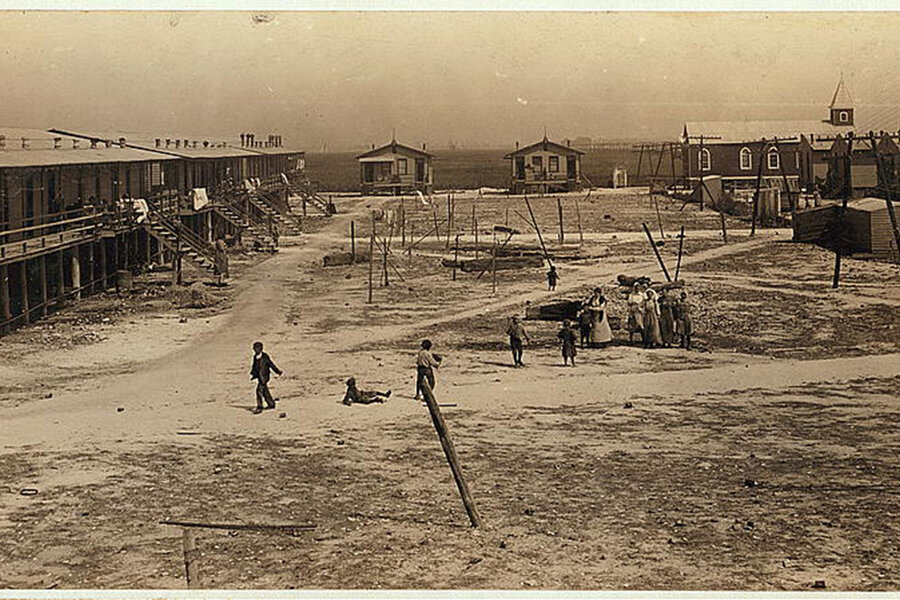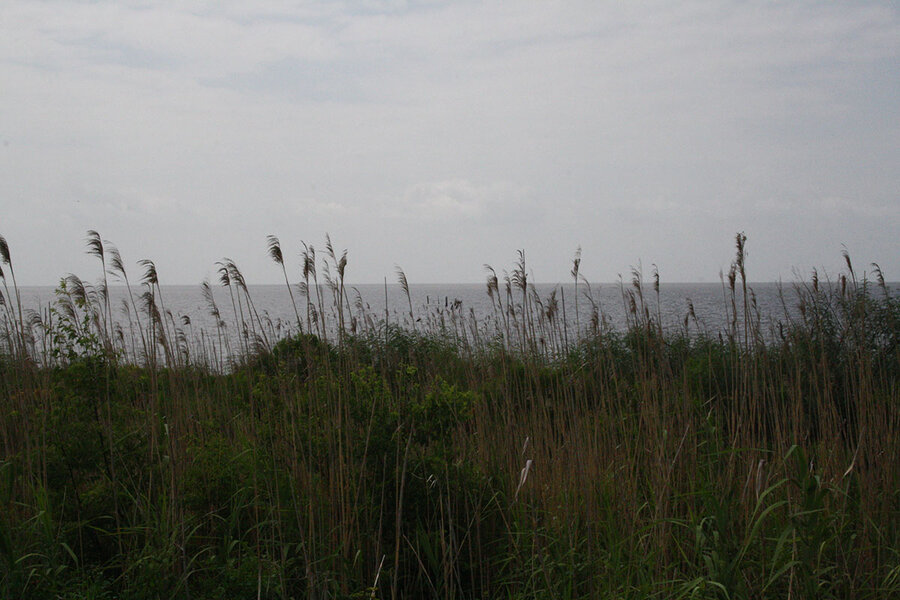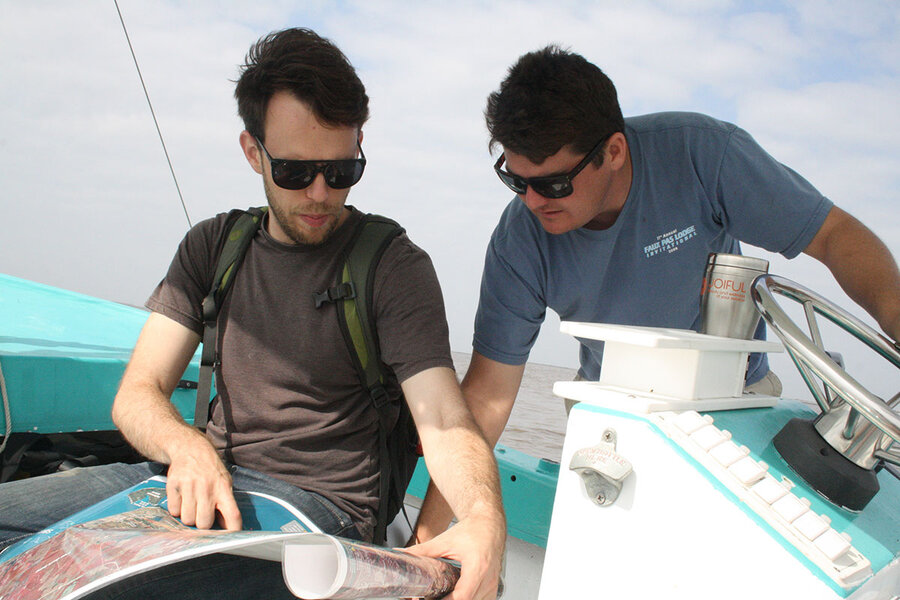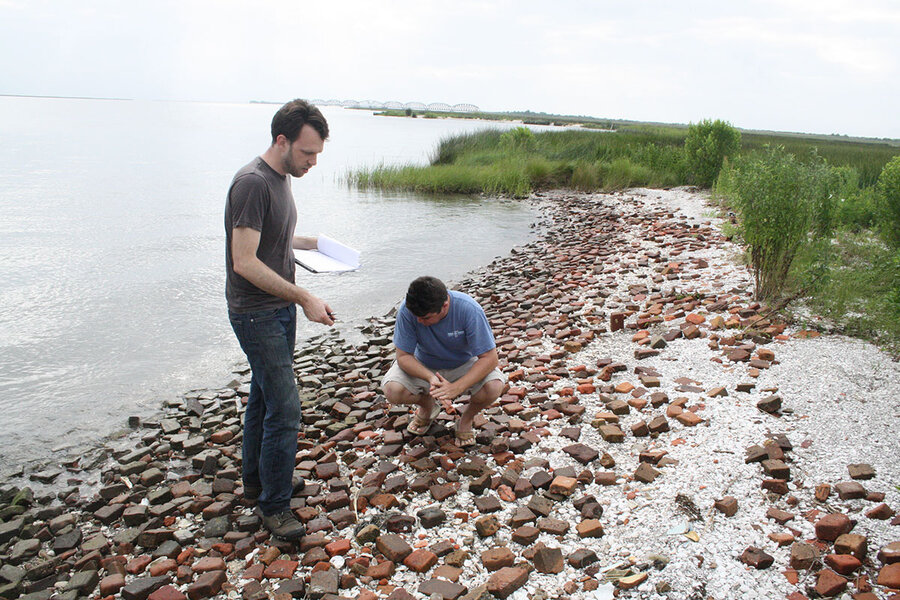Salvage archaeology: When rising seas threaten to wash away history
Loading...
| St. Tammany Parish, La.
The Gulf of Mexico is creeping up over centuries of history south of New Orleans. Inching up through the timeline, Civil War-era forts are now abandoned ruins. Next up for inundation: temporary settlements from around a century ago, along with who knows what else.
The threat of losing long-abandoned settlements may seem minute compared with the millions of people and billions of dollars in economic resources at growing risk as rising seas threaten the Louisiana coast. But to Brian Ostahowski, an archaeologist, the chronicling of Louisiana’s disappearing coastal history is one small area – amid the state’s sprawling, multipronged coastal protection efforts – where he can make a difference.
“I just want to record this before it’s gone,” says Mr. Ostahowski on a gray, humid morning in early June, as he surveys a small beach on Rabbit Island, a narrow spit of marshland about an hour’s boat-ride northeast of New Orleans. “Maybe not to have all the answers, but at least to have them available, so if somebody has a research question [in the future] we’ll have recorded that for them.”
His efforts date back 18 months, to when he met Richie Blink. Ostahowski, president of the Louisiana Archaeological Society, wanted to chronicle historical artifacts along the coastline before they disappeared. Mr. Blink had a boat (the New Delta). The rest, as they say, is history.
Their efforts are becoming more urgent. Blink, a native of southern Plaquemines Parish who works on community outreach for the National Wildlife Federation here, has watched as storms and gradual coastal erosion have damaged or destroyed four of the region's centuries-old forts in recent years.
Hurricanes Katrina and Rita damaged Fort Jackson, a battle site during the Civil War, and successive storms have also crippled nearby Forts Livingston and St. Philip. Livingston has since been abandoned and St. Philip rendered inaccessible without a boat. Fort Proctor, a battle site from the War of 1812, is being “slowly engulfed” by Lake Borgne.
“The more disciplines that are clued into what’s happening the better. When the water’s coming up isn’t the time to go out and study these sites,” he says, tiptoeing around dozens of bricks scattered along the shoreline – the remnants of a lighthouse that operated from the Civil War until the 1920s.
“Getting people to realize this is happening in their backyard in America and not an obscure island in the Pacific Ocean,” he adds, “Anything that can help that out is a good thing.”
Later in the morning, Blink steers the New Delta to two more sites: a ruined oyster cannery in the now-nonexistent town of Dunbar, where Eastern European immigrants settled in the early 1900s; and another area of Pearl Island that had been used as a quarantine station during an 1880s yellow fever outbreak.
The only infrastructure from those days still functioning is the railway. Along the tracks, Ostahowski studies a grainy black-and-white photograph of the old town. Where there used to be houses and people going about their lives, there is now only open water.
Ostahowski's mission, he explains, is to try to ensure that communities marginalized when they were alive aren’t marginalized in the historical record.
“When all that gets destroyed, our ability to understand these groups – where they went, who they interacted with – somewhat softens over time, and eventually we just won’t know anything about these people,” he says. “We’ll just know that they were here.” Recording those remains in as much detail as possible, “gives us a fuller perspective of what our own history is.”
Imagine, for example, what it would mean for future generations if every remnant of slavery was lost to the sea?
That's not to say that the dead are more worthy of saving than the living, he says. “We need to take care of our current communities” on the Louisiana coast, he adds. “But I think some of these histories are worth mentioning and taking a look at.”
This report is the final installment of a four-part series. For the first installment, watch the video below. Click here for Part 2, a look at two towns' very different paths to relocation. Click here for Part 3, a look at Louisiana's $50 billion master plan to protect and restore the coastline.













